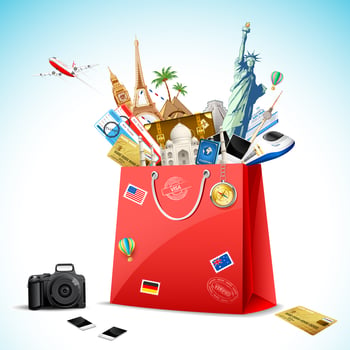Why Shopping Baskets Are a Winning Proposition for Tour Operators
By Nick Ostdick on Dec 20, 2016 10:30:06 AM

Flexibility is the cornerstone of modern travel. In an era where consumers are given more options and more freedom when it comes to booking travel than ever before, travelers are growing increasingly accustomed to the idea that their itineraries should be personalized to their exact desires.
more freedom when it comes to booking travel than ever before, travelers are growing increasingly accustomed to the idea that their itineraries should be personalized to their exact desires.
Of course, such a high degree of freedom and such a tremendous wealth of travel options can become daunting, or even disorienting, especially when it comes to booking tours, attractions, and other activities as part of a trip. However, today’s tour operators are well-equipped to provide value to their customers by helping them make sense of the infinite options available to them.
This is where the shopping basket comes in. In this context, a shopping basket simply refers to the mechanism by which travelers are able to customize their own itineraries, selecting and purchasing transport and accommodations for a tour that would not necessarily have been packaged together otherwise.
The benefits of utilizing a shopping basket for both tour operators and customers alike cannot be understated in a travel landscape where travelers not only have more choice, but increased influence and buying power on the products and services tour operators provide.
Value concept of the shopping basket
Now that we understand the importance of a shopping basket in helping customer curate their own tour and travel experiences - as well as the value proposition for tour operators in giving customers the ability to browse and save multiple offers in one session - we can now examine the value concept of the shopping basket as it relates to different kinds of packaging concepts. The value of the concept rests upon the difference between the two different types of packaging: static and dynamic packaging.
Static packaging: In terms of touring, static packaging refers to different travel components (i.e. transportation, accommodations, and other services) that are grouped together as part of a discrete offering. Usually built upon transportation services (train lines or cruise liners, for instance), with other services built in based on existing schedules, static packages offer travelers the simplicity of a pre-made tour that can be purchased without any logistical hassle.
Dynamic packaging: Dynamic packaging involves disparate travel services from one’s database being grouped together based on the desires of the user. The result is a custom tour package assembled based on an agency’s offerings and the agency-set rules that govern the packaging of those offerings.
Essentially, a shopping basket is the natural outgrowth of a system that can handle dynamic packaging in addition to static packaging. The value here is threefold:
Flexibility: Both B2B and B2C operations could benefit from the ability to generate hypothetical tour packages on the fly, culling from previously unconnected offerings. Doing so would demonstrate a commitment to the needs of an agency’s customers that effectively overturns the perceived rigidity that sometimes created problems for pre-internet tour operations. Users gain value when structure and order are made available to them, but custom tour packages ensure that they don’t have to sacrifice flexibility.
Improved offerings: More than increasing flexibility, a shopping cart functionally increases the breadth of an agency’s offerings—multiplying the possibilities already contained within an operator’s database to arrive at a near infinite number of products that can be sold.
Convenience: Of course, there is nothing to stop enterprising travelers from creating their own tours not just from disparate offerings but from a slew of different tour operators. Without a shopping basket to enable users to conveniently book all of their services from one place, they may turn to different agencies for different legs of their journeys. With a shopping basket, booking all of one’s travel through the same tour operators becomes much more convenient—saving time and ultimately adding value.
Making a shopping basket a reality
Of course, an effective shopping basket is not necessary a simple service to offer. Rather, a tour operator’s ability to dynamically package services depends on how robust their travel booking system is. Luckily, software for tour operators is growing increasingly sophisticated. Today, it is possible to take different elements of an increasingly complex inventory of offerings and connect them such that different types of services can be integrated into one straightforward system. This means that the era of rigid, pre-packaged tours constituting the only option for travelers is drawing to a close. Arising in its place is a world where consumers expect the opportunity to create custom tours that better suit their needs.
By offering a shopping cart to their customers, tour operators can hugely increase their users’ flexibility, while at the same time creating a more convenient shopping experience comprised of a newly-expanded set of offerings. In so doing, tour operators can provide tremendous value to travelers who will be poised to return the favor, turning to these flexibility-minded tour operators for their future travel needs.
- travel technology (58)
- Travel Industry (49)
- travel agency (31)
- travel erp (31)
- travel trends (28)
- travel booking system (23)
- TINA (21)
- travel company (19)
- Tour Operator (18)
- Product updates (17)
- Travel Management Company (17)
- AIDA (15)
- TBS (15)
- dcs plus news (14)
- tour operator solution (14)
- travel website (14)
- travel erp system (13)
- Business Travel (12)
- Mobile App (12)
- Travel App (12)
- mid back office solution (12)
- trends (12)
- Industry Events (11)
- Mobile Technology (11)
- TMC (11)
- travel agents (11)
- erp (10)
- erp system (10)
- Corporate Travel (9)
- Tour Operators (9)
- Travel booking engines (9)
- dcs plus (9)
- online travel agency (9)
- travel agent (9)
- Mobile Bookings (8)
- travel (8)
- travel agencies (8)
- 2017 (7)
- Mobile Travel (7)
- travel business (7)
- travel software (7)
- Digital Technology (6)
- Insider (6)
- Millennials (6)
- Online booking systems (6)
- Travel Management Companies (6)
- process automation (6)
- travel companies (6)
- Big Data (5)
- Business Traveler (5)
- Partners interviews (5)
- Tour Operator Software (5)
- customer retention (5)
- travel agency technology (5)
- Booking engines (4)
- CSBT (4)
- Mobile Device (4)
- OTAs (4)
- Static databases (4)
- Tour Companies (4)
- Travel Policy (4)
- Travel booking systems (4)
- Travel suppliers (4)
- back office automation (4)
- millennial travelers (4)
- online travel (4)
- responsive travel website (4)
- technology (4)
- travel website conversion (4)
- 2016 (3)
- Content mapping (3)
- Databases (3)
- Demographics (3)
- Food and Adventure Tourism (3)
- Mobile Apps (3)
- Mobile travel apps (3)
- Travel Distribution Channels (3)
- Travel Management Software (3)
- Travel customers (3)
- Travel history (3)
- anniversary (3)
- automated processes (3)
- content matching (3)
- global travel industry (3)
- social media (3)
- travel agency workflow (3)
- travel back office (3)
- travel marketing (3)
- travel process automation (3)
- Advanced Booking Systems (2)
- B2B Travel Resellers (2)
- Bleisure (2)
- Branding (2)
- Business Process Automation (2)
- Business Travelers (2)
- Customer engagement (2)
- Financial Reporting (2)
- Food Tourism (2)
- Inbound Marketing (2)
- Infographic (2)
- Leisure Travel (2)
- Saas (2)
- Templates (2)
- Travel Costs (2)
- Travel bookings (2)
- Travel start-up (2)
- Travel website abandonment (2)
- WTM 2016 (2)
- abandoned travel bookings (2)
- corporate self booking tool (2)
- engagement marketing (2)
- internet booking engine (2)
- millennial traveler (2)
- new travel company (2)
- office (2)
- online reputation management (2)
- online travel reviews (2)
- reporting (2)
- software (2)
- start-up tips (2)
- travel agency management (2)
- travel agency website (2)
- travel experience (2)
- travel mobile app (2)
- travel packages (2)
- travel reservation system (2)
- travel system (2)
- travelers (2)
- web-based travel erp (2)
- 2020 (1)
- 360 Customer View (1)
- Advanced Accommodation Contract Management (1)
- Adventure travelers (1)
- Apps (1)
- B2B Reseller (1)
- B2B Resellers (1)
- B2C (1)
- BI Reporting (1)
- Budget traveler (1)
- Cancellations (1)
- Chat (1)
- Chinese millennial (1)
- Cloud (1)
- Cognitive computing (1)
- Comparison shopping (1)
- Conference (1)
- Contact matching (1)
- Content (1)
- Cruise (1)
- Culinary traveler (1)
- Customer relations (1)
- Digital Innovation (1)
- Digital Natives (1)
- Documents (1)
- Emerging market travelers (1)
- Emerging markets (1)
- Errors (1)
- Experimental travel (1)
- Financial Dashboard (1)
- Import rates (1)
- Instant messaging (1)
- Integrate with Accounting Software (1)
- Internet (1)
- Luxury traveler (1)
- Mobile Transaction (1)
- Mobile payments (1)
- NDC distribution (1)
- Operational Reporting (1)
- Reseller networks (1)
- Resellers (1)
- Response (1)
- Subagents Network (1)
- TINA Academy (1)
- TTE (1)
- Travel Reseller Network (1)
- Travel Revenue Management (1)
- Travel booking problems (1)
- Travel finance reporting (1)
- Travel stats (1)
- WTM (1)
- abandonment (1)
- accomodations (1)
- advanced reporting (1)
- airline direct connect technology (1)
- ancillary services (1)
- cloud computing (1)
- collection (1)
- collection challenges (1)
- common data model (1)
- conversion rates (1)
- cost control (1)
- credo ventures capital invests in dcs plus (1)
- customer reviews (1)
- data analysis (1)
- dcs plus credo investment (1)
- dcs plus credo ventures (1)
- deloitte technology fast 500 EMEA (1)
- digital transformation (1)
- e-invoicing KSA (1)
- email marketing (1)
- email marketing for OTAs (1)
- erp e-invoicing (1)
- lost travel bookings (1)
- modern travel agencies (1)
- networks (1)
- new features (1)
- offers (1)
- online customer review (1)
- online reputation (1)
- online travel agencies (1)
- risk management (1)
- sales (1)
- senior travelers (1)
- shopping baskets (1)
- shopping carts (1)
- social network (1)
- standardized processes (1)
- static content (1)
- travel SaaS (1)
- travel account services (1)
- travel agency customers (1)
- travel agency profitability (1)
- travel analytics (1)
- travel blog (1)
- travel planning (1)
- travel reviews (1)
- travel shopping carts (1)
- travel software for agencies (1)
- travel software system (1)
- travel technology europe (1)
- travlist smart mobile app (1)
- trend (1)
- trusted adviser (1)
- trusted advisor (1)
- upsell functionality (1)
- vouchers (1)
- website traffic (1)
- zatca (1)
Subscribe by email
You May Also Like
These Related Stories

What Do Calculators Have to Do with Import Rates?

Essential Software Features for Today’s Tour Operators


No Comments Yet
Let us know what you think